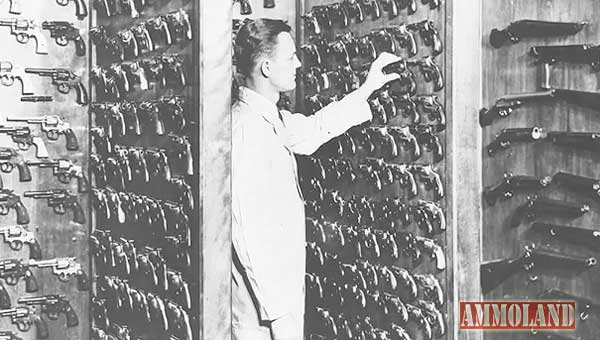

| Visitors Now: | |
| Total Visits: | |
| Total Stories: |

| Story Views | |
| Now: | |
| Last Hour: | |
| Last 24 Hours: | |
| Total: | |
FBI Gun Collection – Firearms That Help Solve Crimes

FBI Gun Collection – The gun collection was created in 1933, a year after the FBI launched the Technical Crime Laboratory, a forerunner to today’s FBI Lab. The new Lab’s mission was to apply a scientific standard to criminal investigations—collecting fingerprints, shoe treads, typefaces, and handwriting samples and comparing them against reference collections of known samples. Gathering known samples of firearms was a logical next step for the Lab, and on October 1, the reference collection officially began.
Washington, DC --(Ammoland.com)- If every gun tells a story, the FBI’s reference firearms collection could fill a very, very large book.
The inventory of more than 7,000 firearms —curated over 80 years— contains just about every make and model, from John Dillinger’s Prohibition-era revolver to the modern battlefield’s M16 and almost everything in between.
Housed at the FBI Laboratory in Quantico, Virginia, the racks of weapons are not a musty exhibit of museum pieces, though some rare items would certainly qualify. Rather, the ever-expanding collection is a hands-on reference catalog for the Lab’s firearms examiners to study, take apart, reassemble, and test fire to support investigations. By maintaining a working library of virtually every handgun and rifle—along with a database of their unique toolmarks—examiners are able to identify and substantiate for investigators what weapons may have been used in criminal acts.
“Oftentimes this collection is used in active cases in comparing known samples from our collection with question samples from the field,” said John Webb, a firearms examiner in the Lab’s Firearms/Toolmarks Unit. “Often, an investigator will receive a part of a firearm or a firearm that isn’t functional. We can take that and compare it with our reference collection, determine what isn’t functioning, and repair it so we can obtain the test fires we need to conduct examinations with bullets and cartridge cases.”
Most of the firearms come from closed investigations, though some are purchased and still others arrive as donations. In most closed cases, guns that were held as evidence in court are sent back to the Lab, where examiners can add them to the reference collection (whole or in parts) or have them destroyed. By continuously adding new pieces to the collection, the FBI aims to have a duplicate of every firearm. Sometimes a case could hinge on linking a firearm component to a similar part on a reference gun.
“The collection has been extremely useful in criminal cases, not only for an examiner’s experience and education in handling nearly every firearm case that comes into the Laboratory,” said Webb, “but it has been directly responsible for assisting to solve crimes.”
The collection goes beyond firearms and includes accessories like suppressors, magazines, and muzzle attachments, as well as grenade and rocket launchers. Another reference collection, the standard ammunition file, catalogs more than 15,000 types of commercial and military ammunition.
While the breadth of the firearms collection is noteworthy, the historic provenance of some of the weapons shows it’s a truly unique cache. Here you will find John Dillinger’s .45-caliber revolver, Ma Barker and her gang’s arsenal, and “Pretty Boy” Floyd’s Colt 1911. There’s an old Thompson submachine gun hidden in a guitar case, and a pistol hidden in the cut pages of a rare first edition of Gone with the Wind.
These aren’t the most important weapons in the collection, however. Examiners will tell you the single most important piece—in a collection that spans more than a century of firearms history and ingenuity—is the one that helps investigators close a case on any given day. The same philosophy has informed the Lab’s meticulous stewardship of the collection for eight decades.
“We are only a small part of this collection,” Webb said. “It was here long before I was, and it will be here long after I’m gone.”
View the Photo Slide Show from teh Collection: http://tiny.cc/ddzqvw
2013-04-18 13:01:20
Source: http://www.ammoland.com/2013/04/fbi-gun-collection-firearms-that-help-solve-crimes/
Source:



